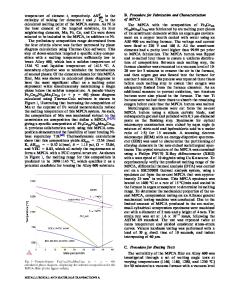Microstructures and mechanical properties of brazed 6063 aluminum alloy joint with Al-Cu-Si-Ni filler metal
- PDF / 999,178 Bytes
- 6 Pages / 595.276 x 790.866 pts Page_size
- 35 Downloads / 348 Views
RESEARCH PAPER
Microstructures and mechanical properties of brazed 6063 aluminum alloy joint with Al-Cu-Si-Ni filler metal Chong Pei 1 & Xin Wu 1 & Guoqing Zhang 2 & Yaoyong Cheng 1 & Xinyu Ren 1 & Wei Wang 2 & Huaping Xiong 1 Received: 4 October 2019 / Accepted: 22 July 2020 # International Institute of Welding 2020
Abstract In this study, brazing experiments were carried out on 6063 aluminum alloy using Al-20Cu-5Si-2Ni filler alloy. Microstructure, mechanical property, and removing behavior of oxide film of the brazed joints were analyzed. The results revealed that the 3% (CsF-AlF3) + 97% (KF-AlF3) non-corrosive flux showed high activity, especially effective removal of oxide films during the brazing process. For the brazing condition of 580 °C/10 min, the brazing seam contained less CuAl2 intermetallic compared with that of 570 °C/20 min and presented a higher shear strength of 126.1 MPa at room temperature. After heat treatment the joint strength was increased to 156.5 MPa. Furthermore, the heat-treated joints subjected to a salt spray test still retained a shear strength of 150.2 MPa. Keywords Aluminum alloy . Brazing . Flux . Shear strength . Heat treatment
1 Introduction Aluminum alloys have become materials of interest for potential applications in the aerospace and automobile industries. 6063 aluminum alloy is widely used in electronic products with its high strength-to-weight ratio, thermal conductivity, and corrosion resistance [1, 2]. It is quite difficult to weld aluminum alloy because porosities and cracks may easily occur during the welding process. Besides, the deformation of the material is also a problem after welding because of the high coefficient of linear expansion of aluminum alloy. On the contrary, brazing is quite suitable for aluminum alloy joining. With low heating temperature, the deformation can be controlled at a rather low level. The brazing seam exhibits good appearance with few porosities and cracks. Recommended for publication by Commission XVII - Brazing, Soldering and Diffusion * Chong Pei [email protected] 1
Welding and Plastic Forming Division, Beijing Institute of Aeronautical Materials, Beijing 100095, China
2
Beijing Non-ferrous Metals and Rare Earth Research Institute, Beijing 100012, China
However, for the melting points of 6063 aluminum alloy and Al-Si alloys are quite close, it is rather difficult to braze 6063 aluminum alloys by traditional Al-Si system filler alloys which are widely used for brazing aluminum alloys [3]. The grain growth and erosion may easily occur during the brazing process, which may cause not only the property damage of the base alloy but also poor mechanical property of the brazed joint [4]. Therefore, it is necessary to develop a new medium-temperature filler metal for 6063 aluminum alloy brazing. In order to solve the problem, a series of low melting point filler metals have been developed by adding other elements into Al-Si alloys. Besides, Zn-Al alloys were also used for aluminum brazing for the low melting temperature [5–8]. However, corr
Data Loading...











